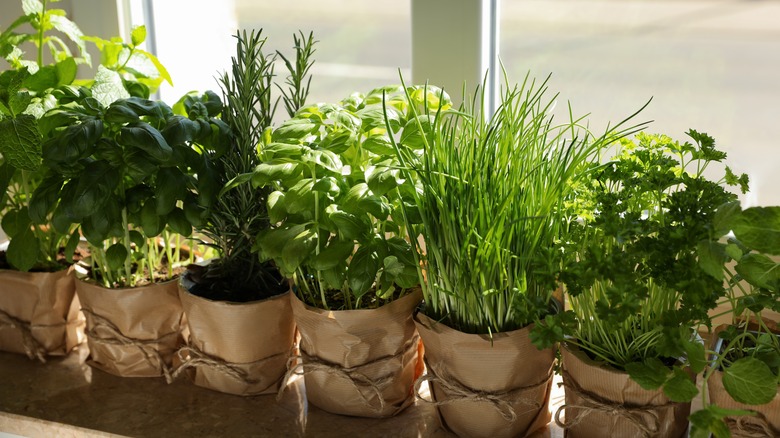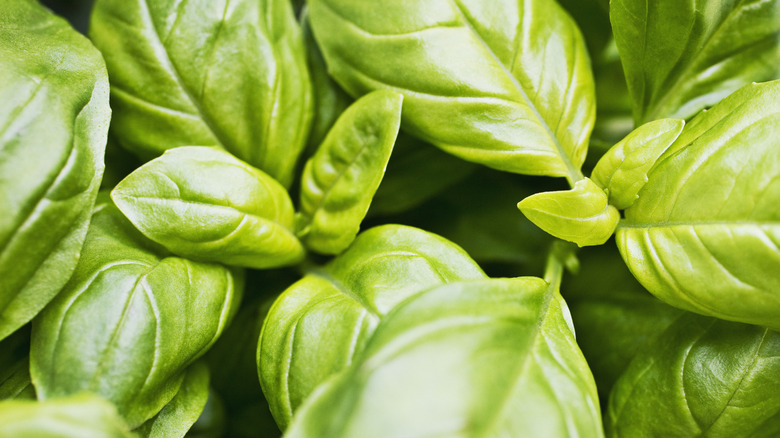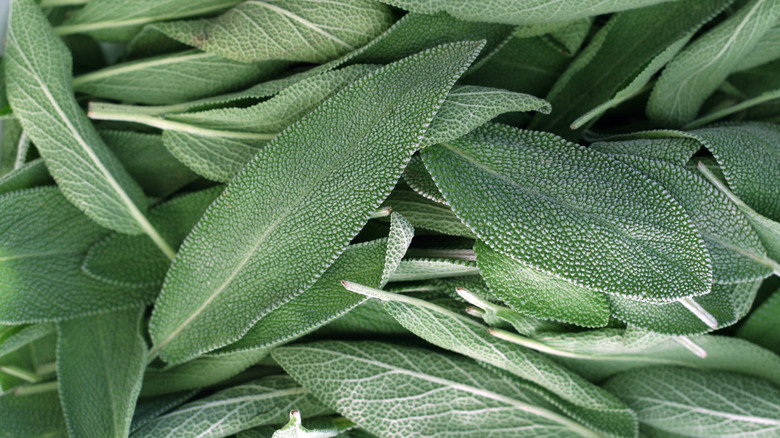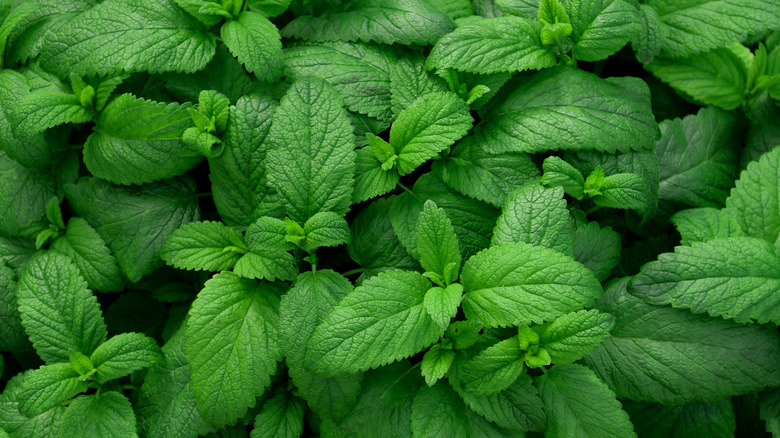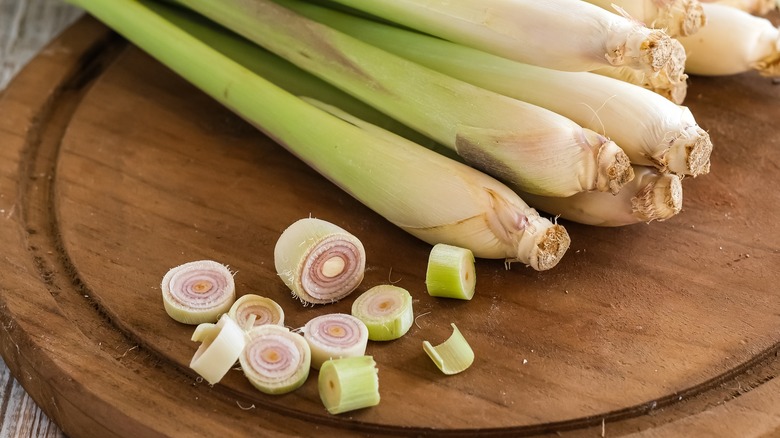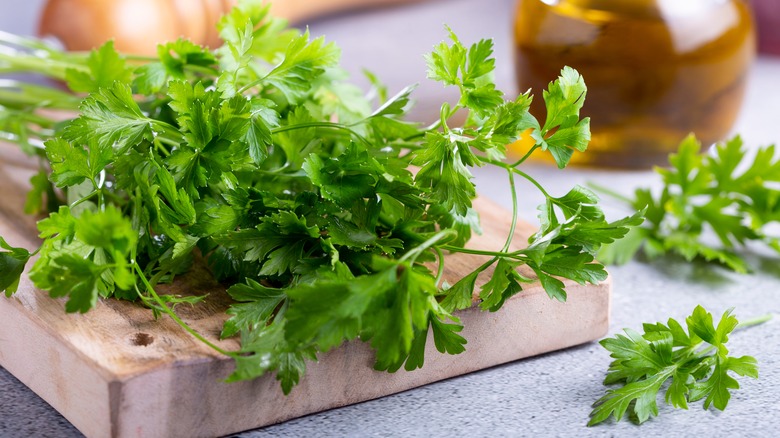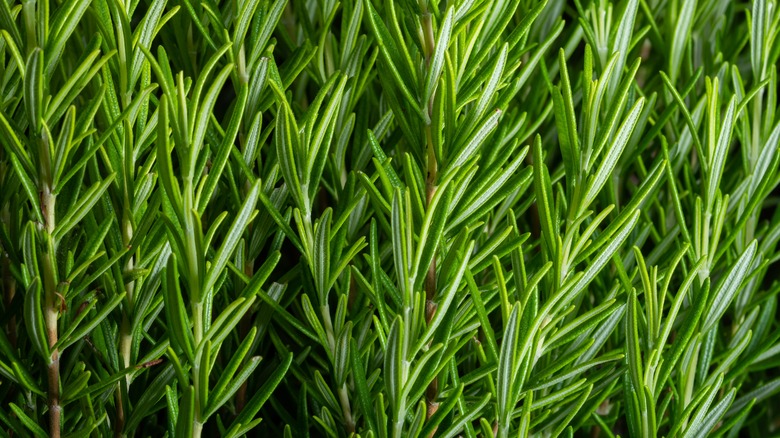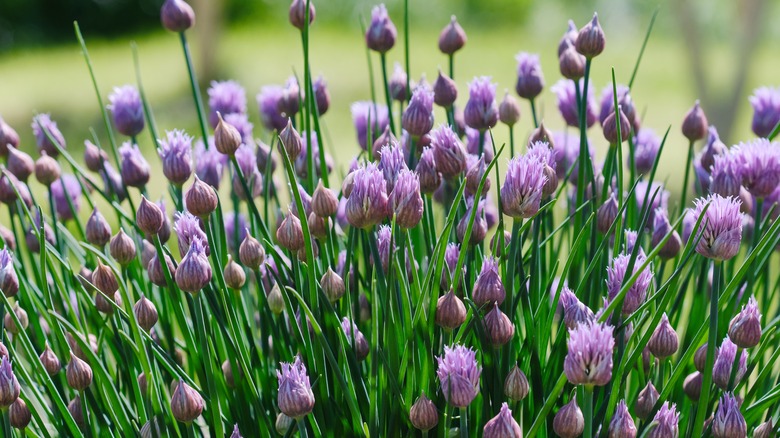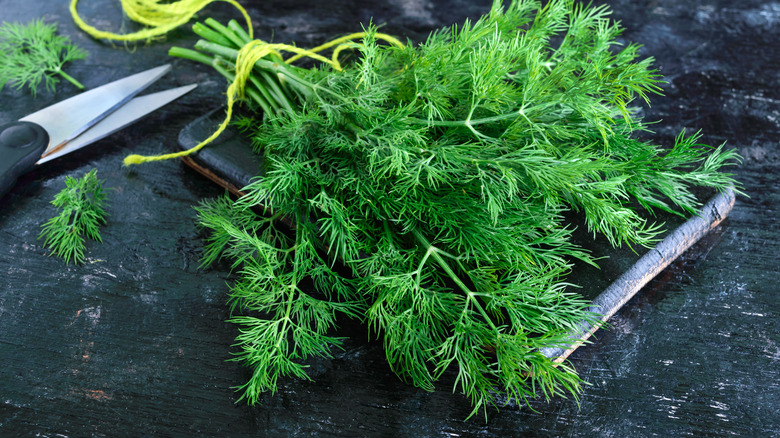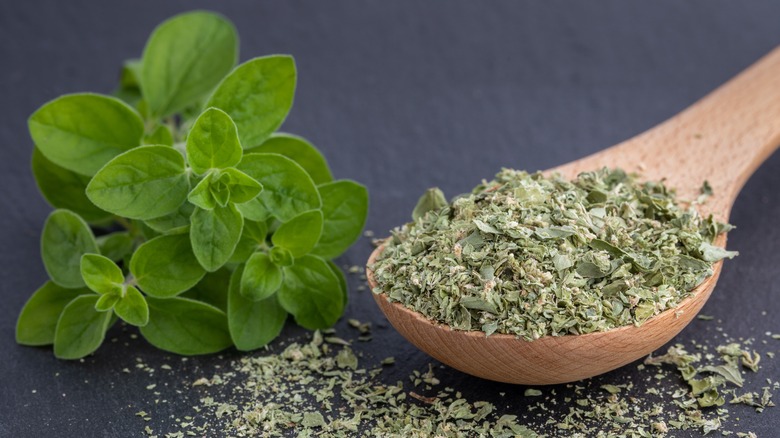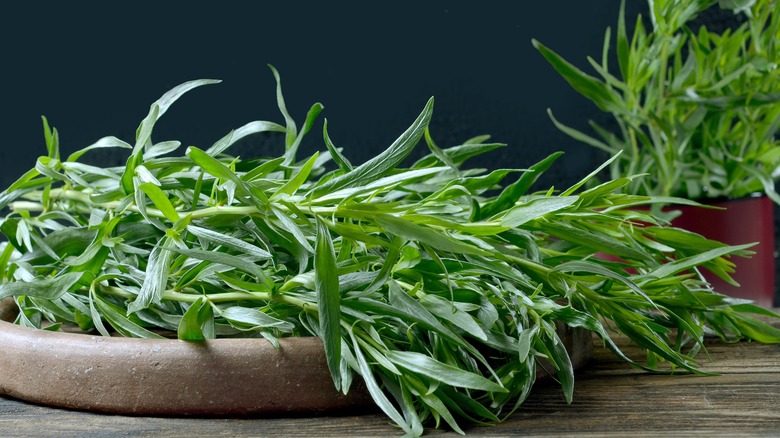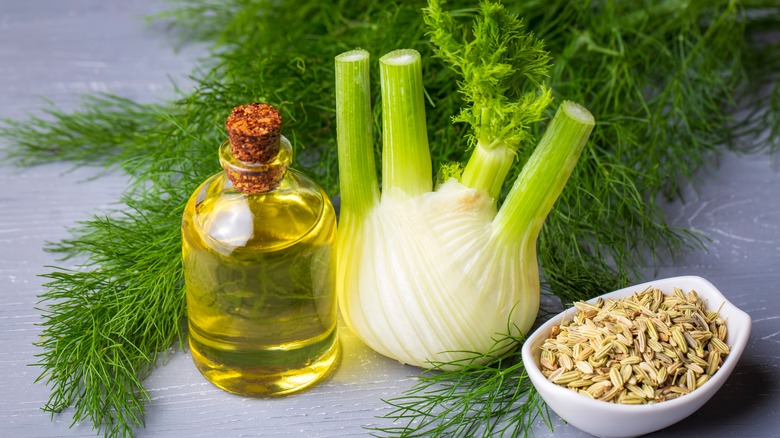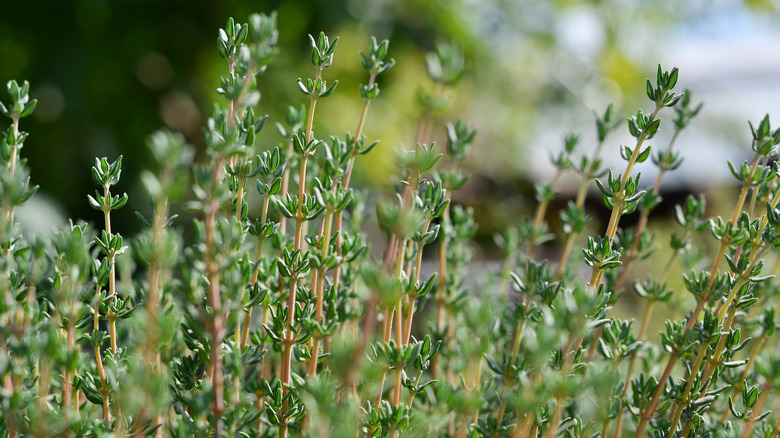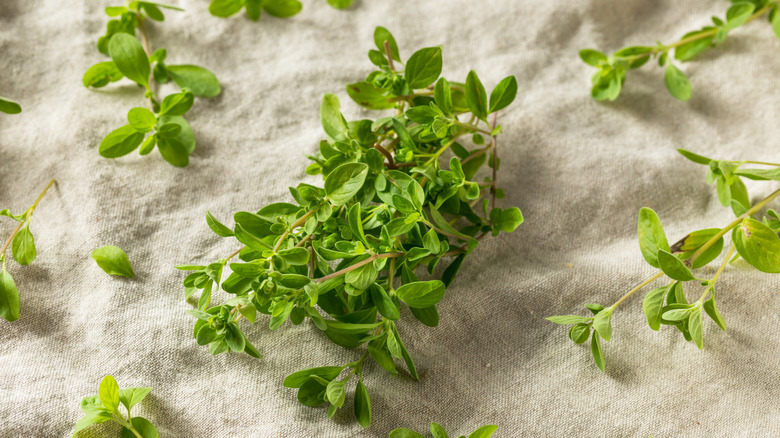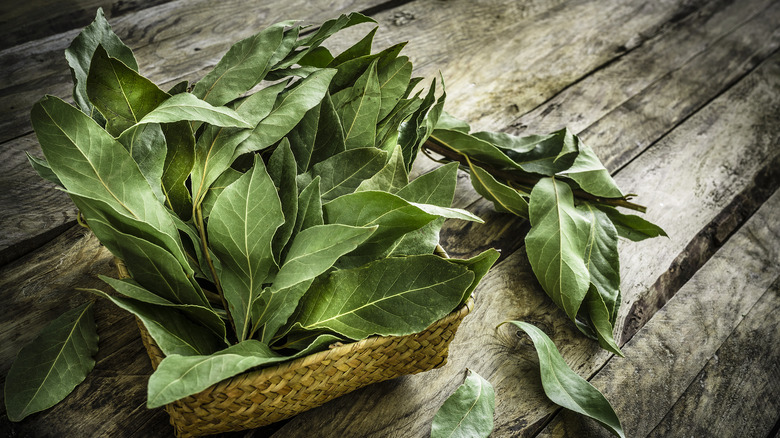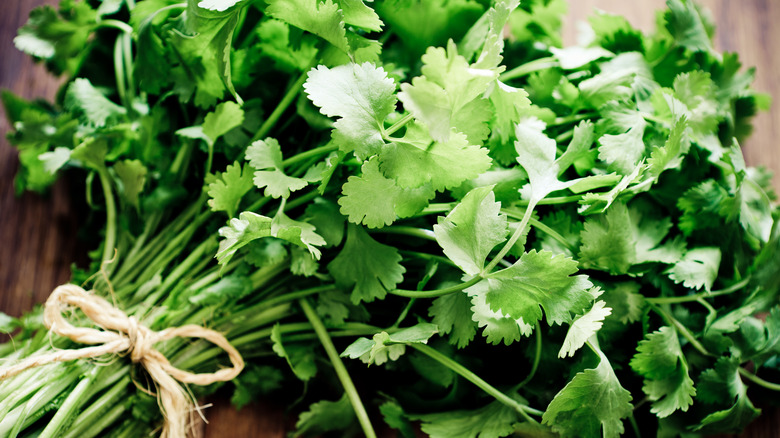15 Common Types Of Herbs And How To Use Them
When springtime finally takes hold, gardeners and home cooks rejoice. Not only is fresh produce on its way, but everyone can look forward to growing fresh herbs. While some green thumbs do this all year round, indoors or in warmer climates, not all are that lucky. Fresh herbs can make a dish go from tasty to irresistible; the key is knowing the common types of herbs and how to use them.
If accustomed to reaching for the salt, pepper, and garlic powder on occasion, but intimidated by the crumbly green dried leaves that typically inhabit a spice cabinet, untouched for what feels like years, it's time to expand your culinary range. Herbs can add depth of flavor, and completely transform a dish. While salt and pepper are a great foundation, they should not be left alone to take on the burden of flavoring an entire dish. Read up for tips on cooking with herbs, to create something truly memorable.
1. Basil
Everyone has enjoyed some basil, even if they don't realize it. If not in the form of pesto, then perhaps in a caprese salad, pasta marinara, or margarita pizza. Basil is sweet and citrusy, with a subtle spiciness to it. The leaves are tender, delicate, bright green, and quite fragrant. Because it's relatively easy to grow, many herb-loving folks opt to have a basil plant growing somewhere in their kitchen, if only for easy access to its fresh leaves.
There are seemingly endless ways to use fresh basil leaves, but for rookies, start by chopping them into thin strips and adding them right into salad greens. Minced or whole basil leaves can be used to garnish almost any Mediterranean dish including soups, pasta dishes, pizzas, and sandwiches. Make a bright and fresh pesto recipe using pine nuts, olive oil, lemon juice, capers, garlic, sea salt, and of course, as much basil as possible. There are a few untraditional ways to use up extra basil, one of which includes making candied basil leaves. Brush basil leaves with egg whites and sprinkle them with sugar. Use these to garnish desserts like ice cream, baked goods, strawberry shortcake — and even fruit salads.
2. Sage
Some might recognize sage for its use as a color theme in Millennial weddings, but sage is far more than a beautiful color. The herb is soft in texture, almost like felt or velvet. It's quite fragrant and can be eaten cooked, dried, or raw. Dried, you can find it crumbled or even powdered, with a spongy appearance similar to fine sawdust. Fresh sage leaves, however, are quite pleasant when lightly fried in hot oil or butter. It becomes crispy and is often paired with butter over pasta. In fact, the two are so bound at the hip that you can even buy sage-infused butter at specialty markets, or find it at top-tier restaurants.
Its strong, musky flavor carries hints of mint and is often used to flavor poultry and sausages. You may even find it in apple sage and sausage stuffing come Thanksgiving. Beyond its flavorful abilities, sage has been more than just a culinary staple for thousands of years. In fact, it's been used medicinally and was an important herb during the age of the Roman Empire. Native Americans also used it medicinally, as well as in rituals.
3. Mint
If you brush your teeth twice a day, which we hope you do, you are likely familiar with the flavor of mint. Within the world of mint, there are actually many varieties, but the most familiar are peppermint and spearmint. Both have a refreshing, menthol flavor, accompanied by a slight sweetness. It's what makes gum so fresh and spicy, and hot peppermint tea sinus-opening. Mount Sinai claims that peppermint can even soothe an upset stomach, so it makes for a perfect after-dinner flavor to accompany dessert. Fresh mint pairs beautifully with dark chocolate, so the little leaves are often used as a garnish for chocolate cakes and delicacies; this dynamic duo can also be found in ice cream, Peppermint Patties, and Junior Mints.
Mint is another herb easy to grow at home, so if starting an herb garden, give this spicy herb a try. Use fresh mint, or dry it for long-term use. There are plenty of tips for cooking with mint, but it's important to note that it can be used in both a sweet and savory capacity. Try adding it to fruit salad, or making a paste along with garlic and salt for lamb chops. It also makes a great garnish for iced tea and lemonade.
4. Lemongrass
Some may wonder, what is lemongrass? While a bulk of the herbs typically used in cooking may look like little green leaves, lemongrass is a bit different. It's fibrous and stalky and bares a close resemblance to scallions, although the flavor couldn't be any more different. It is citrusy, grassy, and floral in flavor and aroma, very similar to lemon. Some palates even detect a hint of ginger root. It is extremely popular in South East Asian cuisines, and can be found in dishes like Thai coconut soup, chicken stir fry, and a variety of curries.
Lemongrass can be purchased fresh, or dried. Either way, when using it keep in mind that the stalk is extremely fibrous. Lemongrass, like bay leaves or cinnamon sticks, can be used to infuse a recipe with flavor, but not be directly consumed in its whole stalk form. By removing the outer layers, the top and the bottom of the stalk, and mincing or grating the white inside portion, the flavor can be released without a resulting mouthful of fiber. Want to make life easier? Consider lemongrass paste as an easier alternative.
5. Parsley
Even if someone isn't culinarily curious and experimental, and herbs are an afterthought, it's safe to say they've come across parsley. Beautiful and lively, it is frequently employed as a garnish to make a visually bland meal pop. Ever go out to eat and get a plate of brown and white food accompanied by a frilly sprig of leaves? Well, that's parsley. While it is beautiful, it has so much more to offer the world than looks alone.
Both flat and curly parsley are fresh, citrussy, and grassy in flavor. Curly parsley is a bit tougher, while flat Italian parsley is more tender. This palate cleanser can be minced up and added to pasta sauce, mixed fresh into a salad, and used in a variety of cuisines from all over the world. In addition, it has some incredible health benefits. In fact, Critical Reviews in Food Science and Nutrition highlights the immunity-boosting and antioxidant properties that the herb contains, even in its dried form.
6. Rosemary
When it comes to strong, fragrant, and intense herbs, look no further than rosemary. It's bitter when consumed raw, but once heated it attains a piney, citrus, sage, and even lavender flavor to it. Its leaves look a bit like those of an evergreen, as they are thin and pine needle-like, growing out of a tall stem. If you're wondering if it is ever okay to use rosemary with the stem attached, it's up to the plant itself. If it's delicate and thin enough, you're a go, but if it has a woody appearance, you'll want to remove it before consumption as it's quite fibrous.
Rosemary is popularly paired with gamy meats like lamb, turkey, quail, rabbit, goat, and venison. If planning on doing a little grilling with wood chips, toss the herb right into the smoker to help infuse it with a mellow flavor. Sprigs can also be used to garnish roasted vegetables and potatoes. Also worth noting: Raw rosemary is great for garnishing mixed drinks.
7. Chives
Onion fans, gather 'round. If you enjoy the sweet, aromatic qualities of onion, chives should be a staple of your herb garden. In appearance, chives look like tiny scallions but are much thinner, milder, and more delicate. Full stalks can be used crisscrossed as a garnish, or they can be chopped up to create a sprinkling of little green "O's" to adorn a dish. Perhaps most popularly, chives are mixed into sour cream and cream cheese to give them a savory, pungent flavor. However, beyond garnishes, there are plenty of ways to use chives in your cooking.
Next time you pick up a fresh bundle of chives from the market, consider mixing them into olive oil or butter to take bread to the next level. Add roughly chopped chive stalks to morning eggs, or mince it to sprinkle over mashed potatoes or potato salad. You can even use chives as a sweet, mild alternative to onions when cooking seafood. If growing your own herbs, use chive flowers to not only brighten up a salad but also to give it a pungent kick of flavor.
8. Dill
This delicate herb is perhaps most frequently recognized as the flavor that accompanies pickles. It's also popularly used to flavor potato, chicken, tuna, and chickpea salads because of its refreshing, citrusy, and grassy undertones.
The leaves themselves are extremely tendril-like and thin, almost lacy in appearance. It can be chopped up and added to salads or kept whole as a beautiful garnish, especially when accompanying seafood. When dried, dill is typically broken up and resembles tiny grass clippings. Both dried and fresh dill is often paired with lemon, creamy or tangy sauces, and lighter fare like white meats. Classically, dill does beautifully to flavor roasted root vegetables, like carrots, and can take the heat when needed.
Dill can help make any dish feel fresher and lighter. In fact, a tangy tzatziki sauce or creamy vegan dill dip recipe can be used not only to dunk fresh vegetables in on a hot summer day, but also as a flavorful and refreshing spread on a veggie-packed sandwich. When in doubt, add it to rice crackers alongside cream cheese and smoked salmon, or cucumber for delicate finger food.
9. Oregano
At almost any pizza parlor across the country, you'll find three specific shakers sitting on the table, available for addition to your pie: parmesan cheese, red hot pepper flakes, and dried oregano. Oregano is quite versatile, and is frequently used in South American and Mediterranean dishes. It's spicy and peppery, very fragrant in both its dried and fresh versions. The plant has small, hearty leaves that when crushed or toasted let out a strong, unforgettable scent.
There are tips and tricks you can use for maximizing the flavor of dried oregano, including using your hands to warm up and crush the leaves. You'll notice right away that its scent becomes stronger, and eventually will translate into a more intense flavor. However, oregano is rather strong to begin with, so be sure to add the herb in moderation. Consider using oregano in poultry and tomato-based dishes, as well as Greek and Mexican recipes.
10. Tarragon
Even if you're well-versed in the world of fresh herbs, tarragon may not be on your radar. Instead of having small rounded leaves, tarragon grows like tall blades, as if it were grass or seaweed. It's often used dried and ground, but can be minced and enjoyed raw in a variety of recipes. It has an intense licorice-like flavor, reminiscent of anis or fennel but certainly distinguishable.
Commonly, tarragon is found alongside chicken and other poultry. Fresh tarragon can be minced and added to chicken salad to give it depth and unique flavoring. It makes a popular addition to roasted carrots, beets, and other sweet root vegetables as well. Although there are some major differences between oregano and tarragon, you can sometimes substitute one for the other. However, if you're trying to replace the flavor as closely as possible, you might want to explore other options that do a better job of hitting the mark.
11. Fennel
Have you seen that big old white bulb with green stalks and feathery leaves at the grocery store and wondered what it is? This is a fennel plant, and the root is quite delicious when consumed, either raw or cooked. The lacy green leaves make for a beautiful garnish and have a delicate, tender mouthfeel. You can even buy dried fennel seeds, which are more intense in flavor and are frequently used to flavor Italian sausage; they can even be made into a digestive-aiding tea, per BMC Complementary and Alternative Medicine.
Like anis, fennel has a strong licorice flavor. However, there are some major differences between fennel and anis. Although similar in appearance, fennel is distinctly sweeter and milder. This is why it can even be found in sweet dishes like fennel cake and rice pudding, or can be enjoyed in combination with decedent chocolate baked goods.
12. Thyme
Everyone would love to have a little extra thyme on their hands; all puns aside, while this common herb is frequently paired with chicken, it has more range than you might think.
Thyme comes in long stems, with little bright green leaves attached. This coloring is key when you're looking to buy fresh thyme. Dried thyme often looks like tiny, soft pine needles with a sage-colored hue. It's not uncommon to see full, fresh sprigs alongside a roasted poultry dish or rack of lamb. Roasted vegetables, especially when they're being prepared for soup, can benefit greatly from the flavorful herb. Even raw thyme sprigs can be found in artisanal cocktails.
In flavor, thyme is slightly lemony, and earthy. It even has mild minty undertones, which are sometimes detectable, especially when consumed raw. This refreshing, light flavor profile is able to hold its own with bold flavors and gamey meats and can be found in popular dishes like chicken noodle soup and shepherd's pie.
13. Marjoram
Resembling a slightly sweeter version of oregano, the herb marjoram is less common but every bit as important to use in everyday cooking. It's mild in flavor, which makes it a great alternative for those who think oregano is just too bold and pungent for their liking. Both are native to the Mediterranean and are heavily used in their cuisine, but marjoram is more commonly found in spice blends. In fact, we think the mild herb deserves a place in your spice blend because of its light yet distinct, sweet, and piney subtleties.
Use marjoram in soups, alongside poultry, and in your Mediterranean cooking. It pairs beautifully with garlic, tomato, and olive oil, which is no surprise considering its roots. Being mild enough to pair with seafood like snapper and even tilapia, it can also hold its own with a rack of lamb or gamy poultry. Don't forget marjoram when it comes to vegetables, like roasted carrots or even mild summer squash.
14. Bay Leaf
Many recipes call for bay leaves, and we diligently add them and then desperately remind ourselves to remove them before serving. Pot roasts, soups, and stews alike are often adorned with huge leaves, but even so, are you entirely sure that you know what they taste like?
Unlike most herbs, we can't bite into them, and rarely get a chance to experience their flavor on their own. As it turns out, bay leaves have a minty, almost black pepper-like flavor, which adds major depth to any recipe. We remove the leaves because they are too fibrous to chew and consume, but they can easily infuse any warm liquid by simply soaking in it.
If you're convinced that bay leaves have no flavor, then yours may not be fresh. In fact, the easiest way to check if bay leaves are fresh enough to even bother using them is by smell, even when dried. The leaves should have a eucalyptus-like scent. Rub the leaf between your fingers to help release the fragrance; if it's subtle, you may want to go pick up some fresher leaves. If that's not an option, then simply increase the quantity used.
15. Cilantro
Did you know that some folks think cilantro tastes horrible? There is a scientific reason, and it results in them thinking cilantro tastes like soap; others, of course, find it to be refreshing, light, grassy, and citrusy. As it turns out, genetics are to blame, not your palate. For those who like the flavor of the delicate herb, there are plenty of ways to enjoy it, both as a garnish and fully incorporated into a recipe.
The bright green herb grows on a long stem with a delicate, flat flower-like leaf, almost resembling a frilly, large clover. It also comes dried and crumbled and can be found in the spice section of the grocery store. Most popularly, cilantro is used to garnish and adds a refreshing flair to South American and Asian cuisine. If you enjoy a tangy, citrus-like pop of flavor to freshen up dense dishes, then look no further than cilantro.
